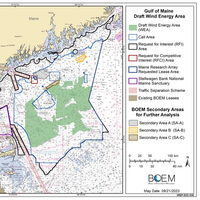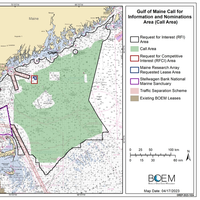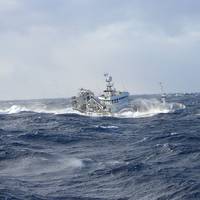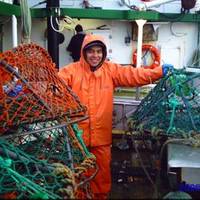40GW Potential: U.S. Regulator Seeks Public Input on Gulf of Maine Draft Wind Energy Area

The U.S. Bureau of Ocean Energy Management (BOEM) on Thursday identified a Draft Wind Energy Area (WEA) in the Gulf of Maine, opening a 30-day public review and comment period. The Draft WEA covers approximately 3,519,067 acres offshore Maine, Massachusetts, and New Hampshire, ranging from approximately 23 - 120 miles off the coast. “BOEM will continue to prioritize a robust and transparent planning process, including engagement with Tribal governments, federal and state agencies, the fishing community and other ocean users,” said BOEM Director Elizabeth Klein.
BOEM Seeks Public Input on Possible Offshore Wind Development in Gulf of Maine

The U.S. Bureau of Ocean Energy Management (BOEM) on Tuesday invited public comment on possible commercial wind energy development in areas offshore Massachusetts, New Hampshire, and Maine.BOEM said the call represented an early step in the commercial planning and leasing process in the Gulf fo Maine, and the first required by BOEM regulations.“BOEM is committed to transparent, inclusive and data-driven processes, and public input is essential to helping us determine areas that may be suitable for offshore wind development in the Gulf of Maine,” said BOEM Director Elizabeth Klein.
Interview: Alison Nolan, GM, Boston Harbor Cruises

Alison Nolan is General Manager and a fourth-generation owner of Boston Harbor Cruises (BHC), a company that moves more than 2.5 million passengers annually on its fleet of 60 vessels with more than 600 daily departures seven ports and more than 30 facilities. But the story of BHC and Alison Nolan transcends raw numbers; as the company and passenger vessel industry are in her DNA, more of a lifestyle than a career. She spoke with Maritime Reporter & Engineering News recently to address the rewards and challenges inherent in her position.
Retlif: Ensuring the Future Today

Ensuring the future today . . . by supporting the U.S. Ensuring the future is an essential part of what a testing laboratory is all about. In fact, that concept underlies every EMC test and all the torturous Environmental Simulation testing that products undergo en route to compliance. Retlif Testing Laboratories, a leading independent EMC and Environmental Simulation testing organization founded in 1978, ensures the future beyond products…with people…from the ground up…with their firm commitment to sponsorship of the U.S. Naval Sea Cadets. The U.S. Naval Sea Cadets program is a vital one.
Critical Habitat for Endangered North Atlantic Right Whale
Using new information not previously available, NOAA Fisheries is expanding critical habitat for endangered North Atlantic right whales to cover its northeast feeding areas in the Gulf of Maine/Georges Bank region and southeast calving grounds from North Carolina to Florida. This final rule, which was initially proposed in February 2015 and received 261 general comments over a 60-day comment period, does not include any new restrictions or management measures for commercial fishing operations. This rule is based on 35 years of aircraft and ship borne surveys of right whale distribution, and research into foraging and prey availability. Together, these data provide a far more robust understanding of the factors critical to species recovery.
DNV GL Tackles Safety through Standards

New classification rules for U.S. fishing vessels address safety issues through collaboration, new rules and an eye towards economy. The commercial fishing industry fatality rate is 30 times higher than the average of other US industries. According to an analysis of commercial fishing fatalities for the period 2000 – 2009 conducted by the Alaska Pacific Regional Office of the National Institute for Occupational Safety and Health (NIOSH), vessel disasters account for 51 percent of fatalities, with the top two initiating events cited as flooding (25 percent) and instability (16 percent).
USCG Cutter Tahoma Returns
Coast Guard Cutter Tahoma returned Sunday to their homeport of Kittery, Maine after a 55-day patrol conducting operations and training in the Gulf of Maine and Georges Bank. The crew carried out Living Marine Resources boardings under the guidance of the 1st Coast Guard District. The Tahoma's law enforcement teams conducted boardings of commercial fishing vessels to inspect safety gear and enforce marine resource management to ensure sustainable fisheries in the North Atlantic. On Dec. 1, 2014 the Tahoma's crew assisted the disabled fishing vessel Madison Kate following an engine casualty. The Tahoma's crew put the vessel in tow and safety and transferred it to a Coast Guard Station Brant Point motor life boat.
UMass Research on Deep-Sea Fish Noise

UMass Amherst Ecologists among the First to Record and Study Deep-sea Fish Noises. University of Massachusetts Amherst fish biologists have published one of the first studies of deep-sea fish sounds in more than 50 years, collected from the sea floor about 2,237 feet (682 meters) below the North Atlantic. With recording technology now more affordable, Rodney Rountree, Francis Juanes and colleagues are exploring the idea that many fish make sounds to communicate with each other, especially those that live in the perpetual dark of the deep ocean.
House Approves Offshore Drilling
The U.S. House of Representatives OK'd a measure by a vote of 236 to 189 to lift a ban on offshore oil and gas drilling. The bill would allow drilling as close as 50 miles from the coast, with seas further offshore than 100 miles opened up completely. The measure prohibits drilling around Georges Bank, a major commercial fishing area. The bill is now due to go before the Senate. It will have to win the support of at least 60 out of the 100 senators in order to be passed, which is unlikely given the lack of Republican support. Source: Marketwatch, AFP
What is in John Garner's Pocket
You don't really know a boat until she's hauled. Plying her trade on the water, her best half's submerged out of sight. We think we recognize her - "oh, there's Odin," or "Shelby Rose," or "Twintube" - but what are we seeing? The lines of the deckhouse, the shape and placement of the wheelhouse, the arrangement of the stacks? These are the parts known as the superstructure - "super," in this case, meaning simply "upon." It's a little like saying we recognize someone by his hat. The boat's defining structure starts at the main deck and goes downward from there. What little we see of it is low on the horizon. There's the deck's line, along with a smattering of bulwarks.
SENESCO Gives NOAA Research Vessel a Facelift
almost unheard-of. maritime rule. back out to sea for another 5-7 years of ocean exploration. Point headquarters in December 2002. National Oceanic and Atmospheric Administration (NOAA). Southern New England to Cape Hatteras, North Carolina. classrooms. year," Albatross IV Commander Michael S. interview. happens once or twice in a ship's lifetime." According to Cdr. contributed to the Albatross IV's unusual longevity. must. occurred in 1988. Proposal (RFP). competing for this job," recalled SENESCO MARINE President Bob Jarvis. NOAA to do business with the growing company. contributed to the SENESCO MARINE choice. factor, but location is important as well. with their families during the half-year repair process. wonders for morale, but it also helped reduce NOAA's costs.
News: SENESCO Marine Gives “Albatross” a Facelift
Most research ships don't live to see there 40's, and to approach 50 is very rare indeed. But the Albatross IV is quite an exception to this rule. Today, thanks to a recent overhaul at SENESCO Marine's (formerly SENESCO) repair facility in Quonset Point, Rhode Island, the vessel is back at its home base in Woods Hole, Mass., preparing to head back out to sea for another 5-7 years of ocean exploration. SENESCO Marine began its a overhaul on the Albatross IV at the company's Quonset Point headquarters in December 2002. Launched in 1962, the Albatross IV is the second oldest in a fleet of 15 research vessels used by the National Oceanic and Atmospheric Administration (NOAA).
SENESCO Performs Facelift on NOAA’s Albatross IV
Most research ships don’t live to see their 40’s, and to approach 50 is almost unheard-of. But the Albatross IV is quite an exception to this maritime rule. Today, thanks to a recent overhaul at SENESCO’s repair facility in Quonset Point, Rhode Island, she is back at her home base in Woods Hole, Massachusetts preparing to head back out to sea for another 5-7 years of ocean exploration. The Southeastern New England Shipbuilding Corporation (SENESCO) began its a major overhaul on the Albatross IV at the company’s Quonset Point headquarters in December 2002. Launched in 1962, the Albatross IV is the second oldest in a fleet of 15 research vessels used by the National Oceanic and Atmospheric Administration (NOAA).







